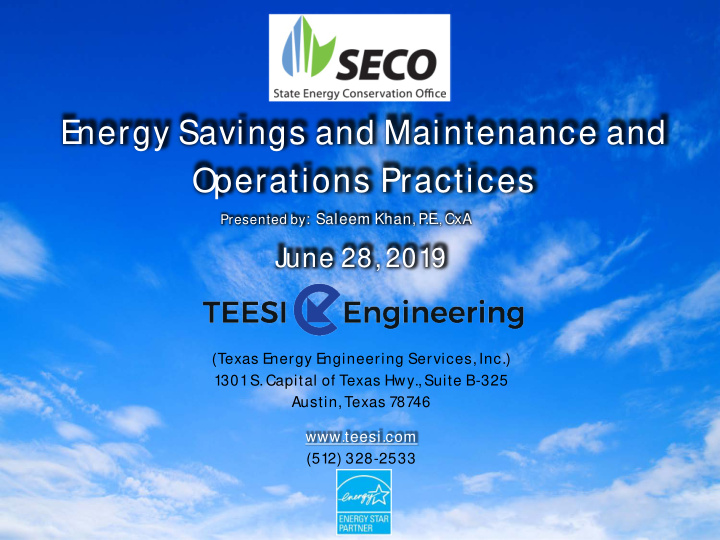



E nergy Savings and Maintenance and Operations Practices Presented by : Saleem Khan, P .E ., CxA June 28, 2019 (Texas E nergy E ngineering Services, Inc.) 1301 S. Capital of Texas Hwy., Suite B-325 Austin, Texas 78746 www.teesi.com (512) 328-2533
Maintenance and Operations Practices Operations & Maintenance (O&M) Operations and Maintenance are the decisions and actions regarding the control and upkeep of property and equipment. These are inclusive, but not limited to, the following: 1) actions focused on scheduling, procedures, and work/systems control and optimization; and 2) performance of routine, preventive, predictive, scheduled and unscheduled actions aimed at preventing equipment failure or decline with the goal of increasing efficiency, reliability, and safety. Source: “Operations & Maintenance Best Practices”, Federal Energy Management Program, Department of Energy, August 2010. 1 of 18
Maintenance and Operations Practices Preventive Maintenance Reactive Avg Maintenance Maintenance Type Breakdown* Preventive Reactive >55% Preventive 31% Predictive Predictive 12% Other ~2% Reliability Centered *From a study in 2000 in the US * Source: “Operations & Maintenance Best Practices”, Federal Energy Management Program, Department of Energy, August 2 of 18 2010.
Maintenance and Operations Practices Operations E fficiency Operational Efficiency represents the life-cycle, cost-effective mix of preventive, predictive, and reliability-centered maintenance technologies, coupled with equipment calibration, tracking, and computerized maintenance management capabilities all targeting reliability, safety, occupant comfort, and system efficiency . O&M department prime objective “keep things running and functional” Source: “Operations & Maintenance Best Practices”, Federal Energy Management Program, Department of Energy, August 2010. 3 of 18
Maintenance and Operations Practices E nergy Management “Energy management is the proactive, organized and systematic coordination of procurement , conversion , distribution and use of energy to meet the requirements, taking into account environmental and economic objectives” Prime objective is to create policies and practices that aim to minimize energy consumption to the maximum extent possible. Source: VDI-Guideline VDI 4602, page 3, Beuth Verlag, Berlin 2007. 4 of 18
Maintenance and Operations Practices Organizational Structure Organizational setup and hierarchy Facilities/Public Works M&O Department Sustainability Department Energy Manager/Department Other 5 of 18
Maintenance and Operations Practices Typically, O&M E nergy Savings Measures… Low-cost or no cost in nature Easily implemented with in-house personnel Quick paybacks 6 of 18
Maintenance and Operations Practices E xamples – Lighting Systems Review Light Levels Inspect and Improve control of Interior and Exterior Lighting Replace incandescent and fluorescent lamps with LEDs Install LED Exit Signs Clean lighting equipment and document lighting levels Group re-lamping or de-lamping 7 of 18
Maintenance and Operations Practices E xamples – HVAC Systems Establish HVAC unit service schedules Maintain boilers/ furnaces Inspect cooling equipment Maintain economizers Test AHU’s Inspect and clean coils, fans, air ducts Replace air filters Maintain controls Sensor Calibration 8 of 18
Maintenance and Operations Practices E xamples – HVAC Systems (cont.) Schedule HVAC equipment operation based on building occupancy Avoid manual operation of equipment Separately schedule temperature control and ventilation Maintain optimum cooling, heating, and setback set points Hail guards on condenser coils Insulate Hot Water and Chilled Water equipment Repair leaking control valves Flush hot water fixtures 9 of 18
Maintenance and Operations Practices Nexuses between O&M and E nergy Management Functions Energy O&M . Management Practices . Practices 10 of 18
Maintenance and Operations Practices Importance of Cross Training 11 of 18
Maintenance and Operations Practices Strategies to Reduce E nergy Waste O&M Practices Behavioral Practices Practices that can be Practices that can be adopted by building adopted by all building custodians, operators, occupants; staff, and managers students, etc. Both requiring very little to no capital investment! 12 of 18
Maintenance and Operations Practices E ffective O&M Program Benefits Energy savings of 5%-20% of whole-building energy use (depending on building type, baseline, & use) Minimal comfort complaints Equipment that operates adequately until the end of its useful life or beyond IAQ maintained Safe working conditions for the buildings’ operating staff 13 of 18
Maintenance and Operations Practices Temperature Setpoints Temperature Setpoints Occupied Cooling 74°F - 76°F Unoccupied Cooling 85°F Occupied Heating 67°F - 69°F Unoccupied Heating 50°F What is the impact of raising the space cooling setpoint by 1 degree Fahrenheit? Approximately 1% reduction of HVAC energy consumption/year! 14 of 18
Maintenance and Operations Practices HVAC Scheduling Schedule HVAC Operation based on building occupancy Cooling, heating, outside air ventilation , etc. Occupancy sensors communicating with HVAC A facility in the NCTCOG region could save 15% of HVAC cooling costs by reducing HVAC operation by 2 hours Assumptions: DFW Climate; 12 month operation; existing EFLCH = 1,267; proposed EFLCH = 1,078 15 of 18
Maintenance and Operations Practices Lighting Lighting makes up 20%-40% of electric bill Turn off lights when not in use! Offices, common areas, kitchen, etc. Turning off the lights for even one hour of per day could result in approximately 10% reduction in lighting energy! 16 of 18
Maintenance and Operations Practices Outside Air Infiltration Reduction Reduce outside air infiltration Weather stripping, leaky ducts, etc. An average exterior doorway without weather stripping could result in approximately $25/year in cooling and heating energy costs! Source: SECO Quick Calcs for DFW area 17 of 18
Maintenance and Operations Practices Discussion and/ or Questions? Saleem K Khan, , P.E .E., C ., CxA TEESI Engineering (512) 328-2533 saleem@teesi.com www.teesi.com Stephen R Ross State Energy Conservation Office (SECO) Office: 512-463-1770 stephen.ross@cpa.texas.gov https://comptroller.texas.gov/programs/seco/ 18 of 18
Recommend
More recommend